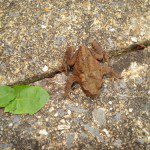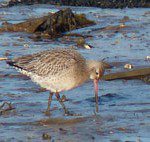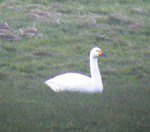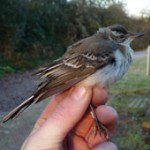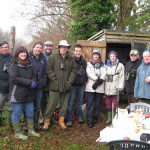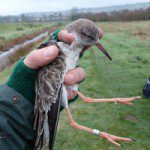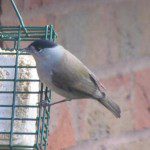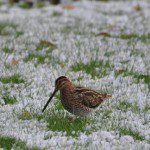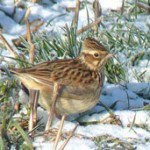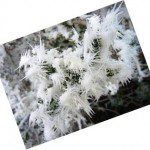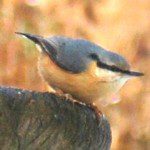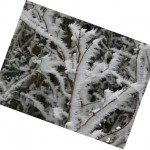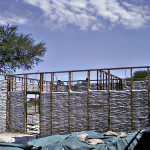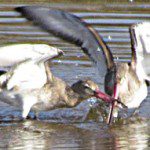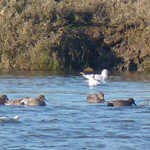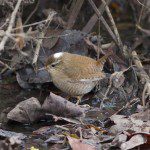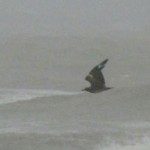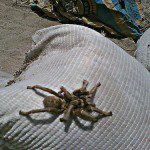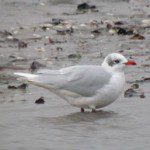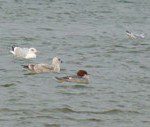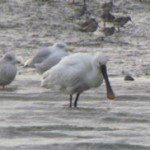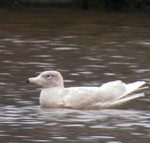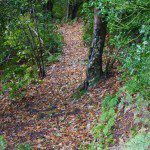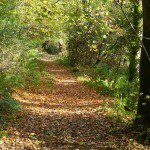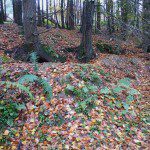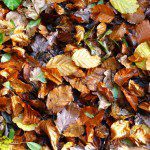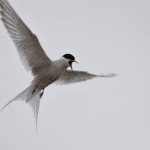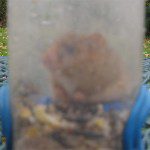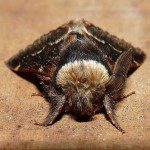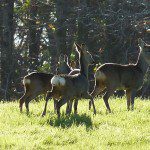Despite the cold weather, Steve has been out and about again, spotting a (fourth) tufted duck down at the lakes, which were still iced over, although a count later in the day revealed there were 14 tufted ducks in total!
Axe Estuary Birds Newsletter #146
NB: The following is reproduced by kind permission of Axe Estuary Birds. Full credit goes to the team that produces the newsletter (see the bottom of the post for specific details). Photographs are credited throughout the text although we are working to preserve the original layout wherever possible in the future.
A Very Merry Christmas to You All, and a Happy New Year
Axe Estuary Birds
No 146 15th December 2010
Images at Colyford by Peter Vernon
The Birds
This period has been incredible for birding on patch, with the cold weather producing an exceptional cold weather movement. Large numbers of wildfowl and waders, thrushes and larks were the main species affected by this.
First and foremost I must mention the Yellow Wagtail currently residing at Colyford WTW – first spotted on 4th. Yellow Wagtail is a summer migrant to the UK, with most birds having left the Country by mid September. The late date, along with the grey and white plumage that this bird shows suggests it may well be of Eastern origin. If it turns out to be a true Eastern Yellow Wagtail then this would be the first confirmed record for the UK. On 14th the bird was trapped and ringed during a routine ringing operation at the WTW, hopefully information gleaned from this will conclusively identify this bird.
Snow on the 2nd kick started an incredible cold weather movement, with totals of 6 Buzzard, 1,453 Lapwing, 30 Snipe, 2,084 Skylark, 2 Woodlark, 90 Wood Pigeon, 1 Mistle Thrush, 63 Fieldfare, 259 Redwing and 86 Starling counted flying west over Seaton. Most of these counts were made between 08:40 – 12:00. Wildfowl were also passing in good numbers, with large flocks of ducks constantly on and flying over the sea. Interesting species and counts included: 2 Goldeneye, 18 Pochard, 12 Tufted Duck, 10 Gadwall, 3 Eider and uncountable numbers of Wigeon and Teal. Also on this date, Woodlarks were discovered in the field opposite Colyford WTW, at least six here – though 18 were counted here the following day.
The day before this incredible day, a Bewick’s Swan was discovered with Mute Swans opposite the entrance to Stedcombe House. It was still present until at least the 7th, soon after this date a Greylag Goose replaced it (which is still present on 15th).
I could write pages about the wildfowl we’ve noted during this period apart from what has already been mentioned for the 2nd. Goosanders have been seen on the Estuary and over the sea on many days, though no more than two at a time. 1,020 Wigeon was the highest count – made on 10th, same day as 12 Gadwall were on the Estuary. Pochard and Tufted Duck have been seen occasionally on the Estuary and on the sea (with counts of 13 and 14 respectively on 8th) and a count of 30 Coot on 9th included 18 on the sea – a highly unusual sight! A single Velvet Scoter was on the sea on 3rd and 10th.
Many notable waders have been seen too, with Grey Plovers noted on 2nd and 8th. Ruff have included up to three birds on Seaton Marshes and the occasional Knot has been seen on the Estuary with a Bar-tailed Godwit also here and a good count of 70 Dunlin on 8th. Two Woodcock were sat out in a field just north of Seaton play park on 3rd, and a single Jack Snipe was in Whitford on 6th with at least 130 Common Snipe.
Up to four Black Redstarts appear to be wintering on patch, although all are quite mobile, and at least one Firecrest can occasionally be seen at Jubilee Gardens in Beer.
Photos: Possible Eastern Yellow Wagtail, Bewick’s Swan, Ruff and Bar-tailed Godwit – Steve Waite; Woodlark – Gavin Haig.
News from Holyford Woods
How still and relatively warm the Woods have been lately without that icy wind. One afternoon a walker’s dog put up 5 Snipe from the open hillside of The Hangings, which flew past me where I was seated on a stump. I had been listening to 2 Ravens, perched in trees a little way apart, one giving three deep rasping croaks, the other answering with a higher pitched single call. Very monotonous over several minutes, it finished with the two birds flying up together, swooping and tumbling. Always a lovely sight. Thanks to a work party of AVDCS members who braved the recent bitter wind, the glade area on the Hangings has been cleared again. The large tree I recently heard crashing down, was just above the top bridge which escaped destruction by a few feet. Another has fallen across the stream lower down. Birds are generally very quiet, though the Nuthatches and Jays are always calling. Now the bracken has collapsed, Paco can again inspect the earths near the main path, and after visiting three, he came out reeking of fox. Jean Kreiseler
Ringing
A very good result for our first canon netting session after qualifying to act alone on December 3rd . Mind you I was somewhat apprehensive, but careful consideration of the improving weather, duck feeding well on grass, plus a little supplement, and a confident team it was decided to go for a catch. The total caught was 191 comprising of 131 Teal, 23 Wigeon, 15 Mallard, 12 Shelduck and a nice surprise of two Shoveler. The by-catch included 6 Black-tailed Godwits, one Ruff and one Lapwing. Two of the Blackwits were controls, one colour-ringed and those that were not were colour-ringed by the team. Overall there were 2 controls and 9 retraps. This was the highest catch since the Group was formed, the previous high catch was of 174 on 10th February 2008. The team were delighted and I was relieved knowing that all birds were safely extracted and processed in good time.
We rang the old year out with suitable refreshments on 13th December. Yes we did catch a few birds as well, totaling 25 as follows: Long-tailed Tit 6(1); Treecreeper 1; Blue Tit 5(2); Greenfinch 1; Robin 5(1); Dunnock 4(1); Blackbird 2; and Wren (1).
The New Year will be rung with a cannon-net catch of duck on 8th January 2011. More details nearer the time.
The Trivia
Alan Bibby reports that there were some unusual birds this afternoon on the playing field between the Underfleet carpark and Seaton marshes: 3 Lapwing, 1 Golden Plover, 2 Snipe & 1 Woodcock which was chased off by two Magpies. “It’s a good site when temperatures go below zero – I think because the row of trees and undergrowth provides some protection from the North wind, and the well-drained turf does not freeze as solid as some of the other fields. In January, it was popular with Redwings and Fieldfares, and there were even two Woodcock and two Snipe feeding in the open. Of course, when it’s warmer there is often disturbance from children and youths. Three more Golden Plover were on the fields between there and the reserve, together with several Curlew, Lapwing & Snipe.”
Anne Smith took this picture in her garden a week before the cold weather set in and thought we might like to see it.
She felt he was rather small for the time of year so safely put him down near her water feature to find some shelter, and hopes he has survived.
Sue Smith, now has a new, and very welcome visitor to her garden, this Blackcap.
John Crabb writes “One thing I have just realised, and it may be of interest to others, is that any of the photographs in the newsletter can be re-sized by clicking on them and then stretching using the little white boxes. This may be useful as I know you are obliged to shrink them to fit your chosen format. When stretched they can be seen much more clearly.”
Helene Buse says “Thought you might like to see this Snipe taken December 2nd. It was firstly on the lawn in front of the house and then went up to the fallen apples in the orchard. Unfortunately I was only able to take the photo through glass. Quite a surprise to see it there!”
Simon Wakely is now photographing the birds in his garden, as this Nuthatch shows. We look forward to more.
Diary Date
Tuesday 28th December Dawlish Warren all day Bird Watch with Ian Waite.
Meet far end of Car Park 10 m An AVDCS Event
This twice-monthly email newsletter is freely available to anyone who would like it, as is a periodic one about the activities of the East Devon Local Group of the Devon Wildlife Trust. Just send me an email with Axe Estuary Birds and/or East Devon DWT in the subject line. Also, for those without a computer, I will send a copy by post if you would like to send me some stamps.
Thanks to those who keep me informed –particular thanks to those of you who have promised me more after Steve “Retires” – please continue to tell me of any unusual, interesting or amusing sightings, and what is about locally, and send any photos you would like to share.
Steve, Mike, Jean and David. davidwalters@eclipse.co.uk. tel. 01297 552616 Mobile 0779 1541 744.
Coots and more
Time for the first in a series of monthly round-ups as we go into December.
Steve Waite has been busy as usual, noting 4 coots down at the lakes, as well as a Cetti’s Warbler. Steve’s site, Axe Birding, is a must-read for anyone with an interest in birding (or moths for that matter) around the Axe Valley.
Also around Colyford recently was the Eastern Yellow Wagtail (Steve was also involved but this was initially spotted by Phil Abbott). See the discussion at BirdForum by Martin Garner, apparently it’s still around.
Only slightly further afield according to @Rarevine there was a Glossy Ibis in the Otter estuary here in Devon too.
Lower Bruckland specific news: despite this cold, cold weather, our intrepid team of photographers (okay, that’s an exaggeration) have been out and about taking snaps of the lakes and their icy surroundings, we hope to have some of these uploaded soon. Just in case anyone does brave it in the sub-zero temperatures, for legal and general well-being reasons be careful near the waters’ edge!
Axe Estuary Birds Newsletter #145
Axe Estuary Birds No 145 1st December 2010
NB: The following is reproduced by kind permission of Axe Estuary Birds. Full credit goes to the team that produces the newsletter (see the bottom of the post for specific details). Photographs are credited throughout the text although we are working to preserve the original layout wherever possible in the future.
The Birds
This period started with rough and windy conditions, and ended with freezing temperatures and snow – what a great month November is!
The windy weather during the first couple of days encouraged a few Little Gulls on to the patch. Single adults were opposite Axmouth FC and along the sea front on 17th, with another (a first winter) on flood water at Axminster. A single Great Skua spent a short while in the bay, coming unusually close to the shore – and the observer!
Once the weather calmed, aside from a few Red-throated and Great Northern Divers, and two Balearic Shearwaters and a Red-breasted Merganser past Branscombe on 21st, it all went quite quiet. But there were plenty of other things to look at!
The cold weather really started to affect birds from about the 28th, with small flocks of Lapwings noted flying south out to sea. Small flocks continued to trickle southwards ‘til the end of the month. Three Ruff flew low north east over Colyford Common on 29th, with five on the Estuary on 30th – with a Knot seen here also. A few Golden Plover were expected, so a flock of above 30 near Musbury on 28th, and 13 near Boshill Cross on 29th weren’t a surprise at all. As ever with this weather, Snipe have become much easier to see, hopefully a Jack Snipe or two will appear amongst them! Four Woodcock were seen in private woodland near Colyton on 30th.
Wildfowl always become more evident on our Estuary during this weather. Best of all were two lots of three Goosanders; on 29th three were on the sea off Seaton then flew off west. The following day three were on the Estuary at high tide. Another two were on the Axe at Axminster from 29th. A few Gadwall included a flock of six on 29th, and highest counts for both Wigeon and Teal were also on 29th, with 450 and 380 respectively. The flock of 12 Brent Geese are now spending all day feeding in the vicinity of Colyford or
Bridge Marsh.
A Spoonbill was a bit of a surprise – but also presumably arrived here due to the weather conditions; it was first spotted on the Estuary on 30th. Up to four adult Mediterranean Gulls have been counted during the afternoon gull roost.
Passerine news is a little sparse for this month, although a Bearded Tit was seen briefly on Colyford Common on 25th, and two Firecrest and a Black Redstart have been noted in Beer. Another Black Redstart, an adult male, was seen in Musbury on 28th.
Photos: Great Skua, Goosanders, Gadwall and Mediterranean Gull – Steve Waite; Spoonbill – Sue Smith.
The Newsletter– HELP! Steve Waite, who has done The Birds section so well for the last two years, is finding it difficult to reconcile with his other commitments, and has decided to give up at the end of this year. We shall miss his contribution, but I shall attempt to continue. However I can’t get out and about as much as I used to, so will rely on your notes and photos even more. Please send all you can to me at davidwalters@eclipse.co.uk . All items published will be acknowledged. Thanks.
News from Holyford Woods
What a glorious show the trees have put on this Autumn, in the lead up to National Tree Week (25th November – December 5th). Even now we can enjoy the gold tops of the Oaks, and the yellow of the Hazels, and all over The Hangings the many young Birches are now showing themselves. From a thick patch Paco picked up the scent of Roe Deer, which I could not see from the main track but he took me down to the bottom path to the very place from where I could just see the Buck and 2 Does happily feeding, sheltered from the cold wind. Although Winter is taking over from Autumn, not everything has gone to sleep, as next year’s catkins are appearing on the Hazels, some of the Honeysuckle is showing new leaf, and the Foxgloves are well up. There are even a few Red Campion flowers in sheltered places. On a late afternoon walk a Tawny Owl was calling at the same time as a Buzzard, and the Corvids were moving back from the surrounding fields to roost, as noisy as ever.
Ringing
On 15th November the team caught 37 birds after a slow start. Lovely sunny morning which produced a nice surprise, a Snipe. in the new reed bed. The tally for the day was:
Song Thrush 1; Robin 7(2); Blackbird 2; Dunnock 14(8); Reed Bunting 4(2); Chaffinch 2; Cetti’s Warbler 1; Snipe 1; Goldcrest 1; Long-tailed Tit 2; Linnet 1; and Kingfisher (1).
Not so good was the attempted canon netting – a fox had been lurking on the marsh, and there were no ducks, so the net was not deployed.
Although we attempted mist netting on the 29th, it was considered after less than one hour to be too cold, so in the interest of the birds (and us!) we packed up. Anyway 3 (1) Blue Tits, one Robin and 5 (1) Dunnocks were caught, all of good condition and weight.
The Trivia
John Crabb wrote “I first thought I had found a rarity, but probably it is just an ordinary Wren with a white patch. It lurks in the corner of the ditch right by the car park at Seaton Marshes.”
Maggie & Ray Dilley on Monday 22nd saw two Redwings on their holly bushes, with lovely strong colouring.
Closer to home, Sue Smith took a wonderful series of photographs of two Godwits having a real squabble. Shame there is only room for one here.
Diana and I are mystified by the almost complete lack of Starlings in our garden. In previous winters we have had a gang demolishing the fat balls, but only the occasional one so far this year.
And now for something not remotely connected to our patch! Our son John, in Botswana, found this Baboon Spider on a sandbag – the body is about 4” long, beautiful to some, horrendous to others. It is one of the Tarantula species. The sandbags are being used to clad the walls, instead of bricks and mortar, (an innovation that has aroused interest in high places) of a school he is building in the Kalahari desert for a village of Kalahari Bushmen, recently resettled in their home land.
Diary
Thursday 2nd December 10.00am to 12 Noon Meet the Birds at Colyford Common.
Wednesday 8th December 10.00am to 12 Noon Winter Birds from the Tram with Donald Campbell
Followed by lunch at Eyre Court Hotel. Book with Christina Bows 01297 238222
Thursday 16th December 10.00am to 12 Noon Meet the Birds at Seaton Marshes.
This twice-monthly email newsletter is freely available to anyone who would like it, as is a periodic one about the activities of the East Devon Local Group of the Devon Wildlife Trust. Just send me an email with Axe Estuary Birds and/or East Devon DWT in the subject line. Also, for those without a computer, I will send a copy by post if you would like to send me some stamps.
Thanks to those who keep me informed – please continue to tell us of any unusual, interesting or amusing sightings, and what is about locally, and send any photos you would like to share.
Steve, Mike, Jean and David. davidwalters@eclipse.co.uk. tel. 01297 552616 Mobile 0779 1541 744.
Axe Estuary Birds #144
Axe Estuary Birds No 144 15th November 2010
NB: The following is reproduced by kind permission of Axe Estuary Birds. Full credit goes to the team that produces the newsletter (see the bottom of the post for specific details). Photographs are credited throughout the text although we are working to preserve the original layout wherever possible in the future.
The Birds
Another period and another American wader!!!
On 9th a Long-billed Dowitcher was found on flood water opposite Axmouth Football Club, just north of Boshill Cross. It was still present the next day but then disappeared. Surprisingly it reappeared again in the same place on 14th. This is the first record for the patch of this national rarity and was found during the search for a Grey Phalarope that had just been seen flying up the river from Axmouth Yacht Club.
There were plenty of other ‘patch goodies’ during this period, with two Bearded Tits on Colyford Common briefly on 1st starting the month off nicely. A Hawfinch flew over Beer Stables on 3rd, on a morning that 1,290 Wood Pigeons were counted flying west. Much larger passages of Wood Pigeons have occurred since, but all have gone over uncounted.
The sea got some attention this period – and offered some nice rewards. A Red-necked Grebe and three Great Northern Divers were off Branscombe on 10th, two Little Gulls flew past Beer on 11th, and the sea from Seaton on 13th showed the, Red-necked Grebe, or another, one Black-throated and five Red-throated Divers and an Eider. A few Brent Geese have been seen passing over the sea, and a flock of twelve spent at least five days in the river valley; at first they were feeding on Colyford Marsh throughout the day, but they now only appear at dusk when they come in to roost.
Gull scanning on the Estuary appeared to be a dead loss this period, although on 12th that all changed when a first winter Glaucous Gull was found near the tram shed. Unfortunately it didn’t hang around and flew off after about five minutes.
The adult Whooper Swan remains with the Mute Swan flock opposite Stedcombe until 13th at least. The following day (14th), a family party of four Whooper Swans were present briefly opposite Axmouth Football Club before moving on. The Axe always seems to do well for this species, they are annual now!
Lapland Buntings are still on patch, with up to three seen and heard on a couple of dates at Axe Cliff. They can be very elusive in the stubble, and hard to pick out amongst the 300+ Skylarks here.
Lastly, just when you think all the signs of summer are long gone….a Swallow was over Colyford Common on 8th!
Photos: Long-billed Dowitcher – Karen Woolley; Glaucous Gull – Steve Waite; Whooper Swans – Gavin Haig.
News from Holyford Woods
The colours this autumn have been exceptional and I have not seen such a rich variety all at once in the Woods for a long time. The paths have been thickly carpeted in a mixture of gold, bronze, copper and yellow. On dry days childishly scuffing through the leaves has been a pleasure. With so many leaves coming off the trees, bird watching will be a lot easier, though birds generally are very quiet, apart from the Jays and Nuthatches. The sound of a gun shot from the pig fields at morning feeding time has been sending a large noisy flock of Corvids into the air, which then descend into the ash trees all along the South boundary. Paco is still annoyed by the sight of Squirrels dashing across paths and leaping around in the tree tops. A prolonged cold spell might mean they depart for easier pickings in people’s garden feeders. The high winds of late have brought down a lot of small branches and twigs everywhere. On my last walk, a particularly gusty day, I heard a large tree at the far West end, beyond the top bridge, come crashing down. At that point I decided to beat a hasty retreat. I will investigate this later.
Below there are few images of Autumn in the woods Jean Kreiseler
Ringing
The ringing on Nov 1st resulted in 32 birds as follows:
Song Thrush 2; Greenfinch 3; Blackbird 2; Goldfinch 1; Wren 3; Cetti’s Warbler 1; Dunnock 11 (3); Reed Bunting 1; Robin 2; Blue Tit 4; Long-tailed Tit 2; Chaffinch 2. Two of the retrapped Dunnocks carried rings commencing with the prefix ‘V’. This puzzled some of the team, but am able to confirm that these were ringed by the Group in 2008 in the crop field. V573478 on 11th December and V573494 on 31st December, both recorded as 3’s.
The highlight of the day was two Bearded Tits which decided to travel through the reeds where at the previous session we placed nets! Anyway a nice rare sighting for the patch.
The Trivia
Nature Explored
Earlier this year, Helene Buse visited the High Arctic. Photographs from this trip will be displayed in the exhibition, including polar bears, walruses and spectacular scenery.
The exhibition will be held at the Guide Headquarters, Rosemary Lane, Colyton, East Devon.
Thursday 25th Nov 2010 4.00 pm to 8.00 pm.
Friday and Saturday 26/27th November 2010 10.30 am to 4.30 pm.
There will be an entry charge (for Guide funds) of £2 for adults (under 18’s free). Light refreshments will be available.
Sandy Beasmon writes “Just to let you know of a Stoat that was seen on Saturday 23rd October at Seaton marshes and within about 20minutes or so had raided the nearby rats nest (by the feeder) 5 times; each time carrying a baby rat back to its nest in the rhyne to the left of the hide.”
A friend in Carlisle writes “A Crow was being blown backward by the wind and managed to land perfectly on the top of a tree – looking very nonchalant as if he had been meaning to reverse there anyway!”
Margaret Barwick says “Around 10 am on this wet and windy morning, (11th Nov,) I went to fill up the bird seed feeder. As I approached I noticed a blob in the feeder , (which is on a 6foot pole) and thought it was soggy seed stuck together. However, to my surprise it turned out to be a Dormouse! It had been a very cold night so we presume it had climbed the pole and got into the feeder then decided to stay overnight and slept in! Whilst we debated how best to deal with it, Steven managed to get some (not very good photos) of it in the feeder. It then pre-empted us by leaping out of one of the holes in the feeder and down onto the gravel.”
Take a look at the Fair Isle webpage below. I assure you it is worth it! Sent to me by John Wood.
http://fair-isle.blogspot.com/2010/11/waxwings-oct-25th-2010-day-well-always.html
Diary Dates
Thursday 18th November 7.30pm Talk by Richard Edmunds “The Jurassic Coast and it Conservation”
An AVDC event at Kilmington Village Hall.
Sunday 21st November 9.00am Birds from the tram with Donald Campbell.
Wednesday 24th November 10.00am to 13.00 pm Walk, approx 5 miles, with Ian Waite. Meet Colyton Town Center
Car Park.
Thursday 27th November 10.00am to 12 Noon Meet the Birds at Seaton Marshes.
This twice-monthly email newsletter is freely available to anyone who would like it, as is a periodic one about the activities of the East Devon Local Group of the Devon Wildlife Trust. Just send me an email with Axe Estuary Birds and/or East Devon DWT in the subject line. Also, for those without a computer, I will send a copy by post if you would like to send me some stamps.
Thanks to those who keep me informed – please continue to tell us of any unusual, interesting or amusing sightings, and what is about locally, and send any photos you would like to share.
Steve, Mike, Jean and David. davidwalters@eclipse.co.uk. tel. 01297 552616 Mobile 0779 1541 744.
A couple more photographs, the Roe Deer from Holyford Woods and the December Moth from Peter Vernon’s moth trap, both taken by Peter.

